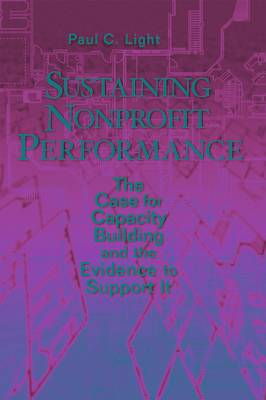
- Retrait gratuit dans votre magasin Club
- 7.000.000 titres dans notre catalogue
- Payer en toute sécurité
- Toujours un magasin près de chez vous
- Retrait gratuit dans votre magasin Club
- 7.000.0000 titres dans notre catalogue
- Payer en toute sécurité
- Toujours un magasin près de chez vous
Sustaining Nonprofit Performance
The Case for Capacity Building and the Evidence to Support It
Paul C Light
Livre broché | Anglais
38,45 €
+ 76 points
Description
""The nonprofit sector survives because it has a self-exploiting work force: wind it up and it will do more with less until it just runs out. But at some point, the spring must break."" America's nonprofit organizations face a difficult present and an uncertain future. Money is tight. Workloads are heavy, employee turnover is high, and charitable donations have not fully rebounded from the recent economic downturn. Media and political scrutiny remains high, and public confidence in nonprofits has yet to recover from its sharp decline in the wake of well-publicized scandals. In a recent survey, only 14 percent of respondents believed that nonprofits did a very good job of spending money wisely; nearly half said that nonprofit leaders were paid too much, compared to 8 percent who said they earned too little. Yet the nonprofit sector has never played a more important role in American life. As a generation of nonprofit executives and board members approaches retirement, it becomes increasingly important to ensure that their organizations are prepared to continue their missions--that they are built to last in a supremely challenging environment. Paul Light, renowned expert on public service and nonprofit management, strongly argues for capacity-building measures as a way to sustain and improve the efforts of the nonprofit sector. With innovative data and insightful analysis, he demonstrates how nonprofits that invest in technology, training, and strategic planning can successfully advance their goals and restore public faith in their mission and capabilities. He explains the ways in which restoration of that faith is critical to the survival of nonprofits--another important reason for improving and then sustaining performance. Organizations that invest adequately in their infrastructure and long-term planning are the ones that will survive and continue to serve.
Spécifications
Parties prenantes
- Auteur(s) :
- Editeur:
Contenu
- Nombre de pages :
- 211
- Langue:
- Anglais
Caractéristiques
- EAN:
- 9780815752257
- Date de parution :
- 31-08-04
- Format:
- Livre broché
- Format numérique:
- Trade paperback (VS)
- Dimensions :
- 161 mm x 229 mm
- Poids :
- 312 g

Les avis
Nous publions uniquement les avis qui respectent les conditions requises. Consultez nos conditions pour les avis.






